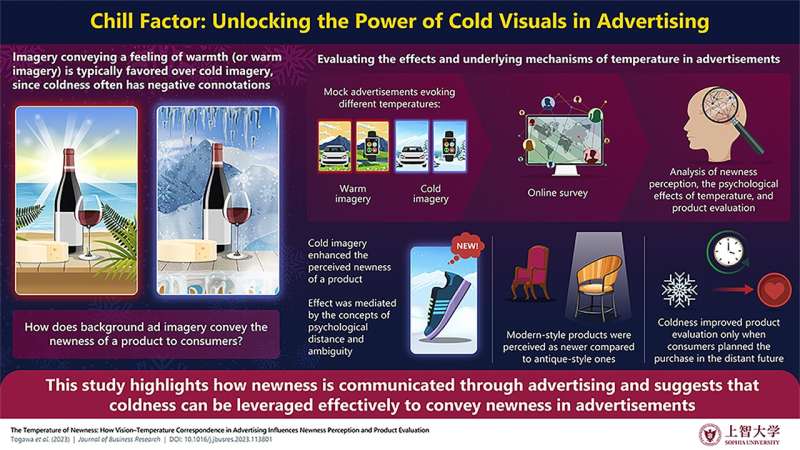This article has been reviewed according to Science X's editorial process and policies. Editors have highlighted the following attributes while ensuring the content's credibility:
fact-checked
peer-reviewed publication
proofread
New study suggests cold imagery creates perception of newness in advertisements

In visual advertisements, the imagery that accompanies the actual pictures of a product is extremely important. Multiple studies and surveys have shown that these images can help evoke specific feelings and communicate key brand- or product-related concepts to consumers. For example, showing accompanying images of lush nature in an ad can instill an idea of "greenness" or "eco-friendliness."
While many different consumer perceptions have been analyzed thoroughly, few studies have focused on how the idea of "newness" can be better communicated to consumers, which is defined as the extent to which a product is perceived as new, innovative, or creative.
To address this knowledge gap, a research team led by Associate Professor Taku Togawa from Sophia University, Japan, investigated whether newness can be conveyed in a rather unexpected way: using cold imagery. "Coldness often has a negative connotation; for example, people regularly use expressions such as 'She gave me the cold shoulder' or 'His comment froze me in place.'"
"Indeed, consumer researchers have shown that warm temperatures increase consumers' evaluation and purchase intention for a given product more than cold temperatures," explains Assoc. Prof. Togawa, "However, our study sought to prove that, in the context of advertising for new products, coldness is not always a negative factor in consumer behavior."
This work was co-authored by Dr. Hiroaki Ishii from Aoyama Gakuin University, Dr. Jaewoo Park from Chuo University, and Rajat Roy from Bond University, and their paper was published in the Journal of Business Research.
First, the researchers considered the psychological mechanisms of newness perception using construal level theory (CLT). In short, CLT is a social psychological theory that states that the way people construe or interpret an object depends on the "psychological distance" between them and the object. When an object is psychologically distant, people tend to perceive it in more abstract and general terms, focusing on its broader features and meaning.
Based on a previous finding that the perception of coldness can increase a subject's psychological distance to an event or object, Assoc. Prof. Togawa and colleagues theorized that cold imagery could be leveraged to enhance the perception of newness for a product. Put simply, by amplifying the psychological distance to a product using cold imagery, the consumer's perceived ambiguity about that product will increase, which in turn will cause them to identify it as "novel" and engage their curiosity.
The team verified various aspects of their hypothesis by conducting four different experiments. In each, an online survey was sent to over a hundred participants, which were shown fake product ads with accompanying "cold" or "warm" imagery. For example, one ad for a car either had an accompanying photograph of a snowy landscape or a sunny green field.
The first experiment confirmed that coldness was indeed statistically associated with a higher perception of newness in the survey participants. Meanwhile, the answers in the second experiment verified that coldness led to a higher psychological distance, and therefore higher perceived ambiguity and newness.
The third experiment showed that using cold imagery was effective at increasing perceived newness for modern-looking products, but not for antique-style products. Finally, the fourth experiment indicated that the perceived newness enhanced by cold imagery improved the consumer's evaluation of the advertised product, but only when they were hypothetically planning to buy it in the distant future rather than in the short term.
Taken together, these findings provide much insight about how coldness can be effectively leveraged in visual advertising. "Our results will contribute to building a theoretical framework explaining how newness perception is communicated through advertising," says Assoc. Prof. Togawa, "We believe marketers may be able to communicate product newness more easily, quickly, and inexpensively by using background imagery related to coldness in their advertisements rather than altering the style and features of the product itself, which is costly."
More information: Taku Togawa et al, The temperature of newness: How vision–temperature correspondence in advertising influences newness perception and product evaluation, Journal of Business Research (2023). DOI: 10.1016/j.jbusres.2023.113801
Journal information: Journal of Business Research
Provided by Sophia University



















